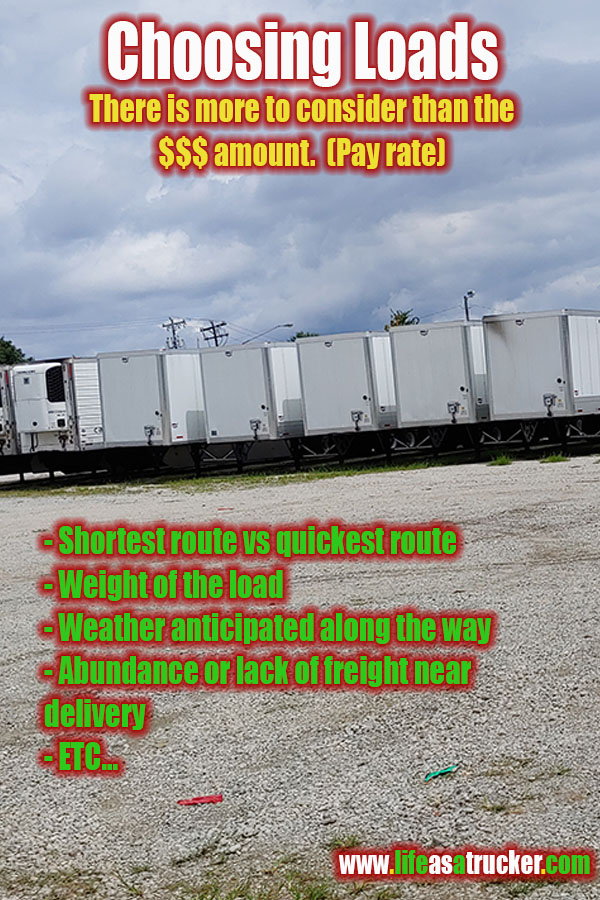Trucking IQ - How much do you know?
Loading...
⚠️ SECTION 1 COMPLETE
Points Accumulated:
If your score wasn't perfect don't worry.
You are here to learn. We make it fun!
Now, let's see if you know the "Unspoken Rules."
These are the habits that take you from Rookie to Professional.
Loading...
🎉 Assessment Complete!
Where should we send your results?
🔒 Your results are private.
Includes free Trucker Success Tips.
🏆 YOUR TRUCKING IQ
Your Final Score:
We will explain all of the answers inside the Trucker Success Quickstart.
Click above to access the full breakdown and training.
How to Choose Loads
When you are choosing a load to haul there are many things that you should consider first as an owner operator. Of course it could vary based on the type of trucking job you have.
For example a hazmat tanker driver might consider things that are irrelevant to a bed bugger/household driver which could differ slightly if you're pulling a flat bed driver.
This page will give you general insight as an owner operator choosing loads because it could mean making more money. Also known as your profitability. (Company drivers may have less options)
- The weather for the route you need to take
- If the shortage route has restrictions for what you're hauling
- The abundance or lack of freight where you will delivery the load
- The time that you pick up and deliver
- Whether the most direct route is highway or back road
- The congestion level in relationship to the appointment times
- The weight of the load
- The type of place you're going to
Pay Close Attention to Routing
Biggest mistake for truckers is being cheap and using google maps only instead of a motor carrier map and/or Semi GPS. The routes are not the same! Pay close attention to the routing options and suggested routing given by GPS.... Even if it is a Commercial GPS
You will also see that routing is a factor is other sub headings of what to consider as well.
Shortest Route Vs Longer Route
If there are several options, make sure the one highlighted as the shortest doesn't take more time than the longer route.
If you're new, this might sound ridiculous. Think about it though.....
If the shortest route has you going through back roads and/or cities and traffic lights. Just because the mileage is shorter doesn't mean you will get there quicker than going further and using the interstate most of the way.
So don't just go by the shortest mile.
Shorter Load or the Long Run?
Longer run might look good at first because the total pay likely is more than a run for half the distance. The important thing to consider is the rate per mile.
As stated in the video shorter runs will pay you more per mile than longer runs.
Let's say you see a load going from Durham NC to Ft. Worth, Tx that pays $2,280 for the trip.
Or a load from Raleigh NC to Tuscaloosa Al about 600 miles for $1500
Which do you choose?
Well the longer trip is $1.90 per mile.
The shorter trip is 2.50 per mile. It's much more profitable.
For example 4 loads of about 600 miles in 1 week averaging $2.50 per mile. 2,400 miles in the week is about $6,000.
Or 2 loads of about 1,200 miles each totaling about 2,400 miles for the week averaging a pay of $1.90 per mile. Would give you $4,560
That's a difference of $1,440 dollars.
You have to take into account the time it will take you to get loaded, haul the load and get unloaded days of straight driving and whether that load carries you over the weekend or not and the location but you get the idea. It's not a black and white choice to determine profitability. So pay attention. No cheap freight!
The Routes to Get There
Some deliveries don't have a good direct route from where you are located. A load might be 500 miles and unless you map it out you might assume that you can run it in 8 hours. (I usually use 60 miles an hour to calculate time. So I have a cushion of time to play with. )
However, if more than half of the run is on backroads and thru stop lights it's going to burn up a lot of extra time and fuel. So you have to compare the routes to get there when you are choosing a load.
Suppose the load is heavy vs a light load. A heavy load through back country might pay more than a light load. But you will burn a lot of fuel. Or you might take a longer route than the back roads with a heavier load to avoid the stop and go. Will burn less fuel on a 500 mile trip adding 50 miles to avoid stopping and going.
Weight of the Load
Hopefully you're not running around with less than 400hp under the hood! That said, just because you can haul heavier freight because you have plenty of power doesn't mean you should be quick to jump at the those loads.
If you choose to haul a heavier load (I say over 40,000 lbs) make sure it's paying more than you would charge to haul the same load under 30,000 lbs.
ESPECIALLY if you have to hit a lot f back roads, go through traffic lights or go through a lot of mountain terrain.
All of these things will take you longer and burn more fuel which mean cutting into your profit.
You are better off just letting the load sit and if we all handle this similarly the broker will have to raise the pay of those loads.
So I know that you might have to weigh (pun intended) the cost of sitting and not taking a load with taking a load that pays less than you would prefer. (Well, in that case, you have to do what you have to.)
Personally, I will sit another day if a heavy load is all that is available and they won't bay above the average price to move it. Because the average for that load means that more has been paid enough times for the average to be what it is.
Cheap freight is for suckers unless it serves YOUR purpose. Like maybe you need to get home for an important reason and that load is all available. OK, they got you. That's a reasonable exception.
Check the Weather
Check the weather for the route you will be taking. If you can, avoid driving into inclement weather.
Make sure you are happy with the detention you will receive if you will have to pull over and wait for bad weather to pass over.
In my case, I just rather to avoid loads that require me to use a route that goes through inclement weather. Of course, sometimes you can avoid the weather by adding 50 - 100 miles to your trip.
This may be Ok for an owner operator, just make sure your pay makes up for the extra miles.
(However if you're a company driver, they may not let you go a longer route. But they might let you refuse the load based on weather.)
Example: From Greensboro NC to Memphis TN using I 40 is 50 miles shorter than taking I 85 to Atlanta and going across I 20, then coming up to Memphis using US 78.
But it can easily be a snow storm at the Tennesse/North Carolina line or ice using I 40 while but going I 20 can be pleasant and dry.
Of course you want to check the weather for the date that you will be arriving and looking for another load as well.
Load to Truck Ratio
Be aware that there are lanes that have heavy truck freight and others that don't. You need to know that there is good paying freight nearby where you will deliver your load.
You can find the load to truck ratio in the DAT load board.
For example, If you deliver in the middle of a desert, it might pay well to go there. Western Texas for example. But what is the closest place that you might get a load out.
Hint: If you decide to take such a load, start trying to book another load immediately. Don't wait until you've delivered.
Loads pay well going into Florida and California however, coming out the loads will pay horrible. So something else you must consider.
Unless it's watermelon season in Florida. Or you have a refrigerated trailer for produce coming out of California. Then you might be able to get paid well going in and coming out.
How Much Time You Have Available
You have to look at your clock and figure out if the pick up and/or deliver times will work with your available hours left to drive. (Log book)
You MUST take into account whether you can pickup and deliver the load you choose legally without running out of hours.
Don't take load that you can't run legally. And don't take it, if you must work out perfectly to run legally. Usually things take a little longer than you plan during the pick up, delivery or transit time.
Type of Place You're Going To
For example Grocer warehouses, some distribution centers and certain other places could just burn all your time up waiting to load and unload.
So do a search for reviews to get intel on what to expect when picking up and delivering at those places.
It might pay a little more to go to these places, but if you are going there say on a Friday morning and when you finish it's after 1pm in a town that typically have light freight available to haul, it could be a bad idea to choose that load.
However, it might make sense to haul the load Monday through Thursdayl
- Top of the Page
- Where do you find loads
- How to Negotiate Freight Rates
- 5 Hacks for getting higher freight rates
- Tips for New Drivers
- Becoming a Truck Driver
- CDL Training Options
- Advantages and Disadvantages
- Trucker Slang and CB Talk
- Types of Truck Driving Jobs
- Choosing Trucking Company






New! Comments
Have your say about what you just read! Leave me a comment in the box below.